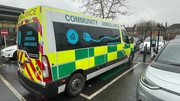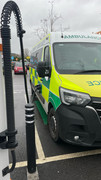Page 1 of 2
Trialling an electric Ambulance
Posted: Thu Feb 20, 2025 2:25 pm
by dan_b
Re: Trialling an electric Ambulance
Posted: Thu Feb 20, 2025 4:51 pm
by dan_b
Well what a bizarre coincidence!
Just had to do a splash and dash at Sainsburys (they've got a nice new Kempower-based rapid charge hub, although the prices aren't quite so nice!) and spotted an EV ambulance! Not the same one as the above story which is a Ford platform, but nonetheless!


Re: Trialling an electric Ambulance
Posted: Thu Feb 20, 2025 9:22 pm
by ecogeorge
Can't help but chuckle inside at a slowed Nee Naa siren noise as the battery runs down ............... i'll get my coat...
Re: Trialling an electric Ambulance
Posted: Thu Feb 20, 2025 9:57 pm
by Moxi
On the plus side the defibrillator will pack one helluva punch !
I will also get my coat …… again ……..
Moxi
Re: Trialling an electric Ambulance
Posted: Thu Feb 20, 2025 10:04 pm
by Krill
If they put chargers at A&E the ambulances will spend more time at full charge than any other state.
That's not actually a joke. Or maybe it is. I don't know anymore.
Re: Trialling an electric Ambulance
Posted: Thu Feb 27, 2025 11:33 pm
by MikeNovack
Krill wrote: ↑Thu Feb 20, 2025 10:04 pm
If they put chargers at A&E the ambulances will spend more time at full charge than any other state.
That's not actually a joke. Or maybe it is. I don't know anymore.
No, not a joke. An example why the "duty cycle" of a vehicle plays a major role in deciding how suitable for being EV. HOPEFULLY an ambulance, a fire engine (except a pumper), etc. spend most of their time "on standby" and then when actually called, travel only a short distance to and fro. I put in the "except a pumper" because that unit would be using power while at the fire, possibly for hours, not just getting to and fro.
BTW -- it isn't just range that matters but also power. I might have a vehicle that never travels more than 50 miles round trip but if the battery had only the energy capacity for that it might not have enough power (how fast can energy be going into or out of the battery without damaging it). If an EV car has a 200 mile range it probably would have enough power (say to get on to a g=highway, climb a 5% grade at normal speed, etc.
Re: Trialling an electric Ambulance
Posted: Fri Feb 28, 2025 9:35 am
by knighty
I know someone who works at an ambulance depo (where they work on / fix ambulances)
all the ones they have in have absolutely massive miles on them, not sure electric could keep up with that
Re: Trialling an electric Ambulance
Posted: Fri Feb 28, 2025 10:21 am
by Countrypaul
As always horses for courses, putting an electric ambulance of the current crop might be a problem in a rural area where they might cover hundreds of miles on an abverage day. Putting one in the centre of London where 50 miles would be considered well above average would seem very appropriate. Using ICE in London would also seem to be unnecessraily contributing to the aleady high polution levels.
Re: Trialling an electric Ambulance
Posted: Fri Feb 28, 2025 2:24 pm
by Oliver90owner
‘Orses for courses as usual. Not all ambulances are required for emergency calls. There is a place for them in a fleet, as a a starter, just ferrying patients to and fro. See how they develop, as time goes on.
I expect that, eventually, they will take over from ICE, but not immediately. Rome wasn’t built in a day!
Re: Trialling an electric Ambulance
Posted: Fri Feb 28, 2025 3:51 pm
by MikeNovack
Countrypaul wrote: ↑Fri Feb 28, 2025 10:21 am
As always horses for courses, putting an electric ambulance of the current crop might be a problem in a rural area where they might cover hundreds of miles on an abverage day.
I live in a rural area (VERY rural by your standards) and almost all round trips for ambulances would be 50 miles or less. Yes, that could be hundreds of miles per day but not hundreds of consecutive miles. There would be plenty of time between calls for them to feed. On the other hand, less favorable for fire engines. Why? Because almost all of ours "pumpers". In the villages there may be hydrants and "town water" under pressure. But for >90% of the area they cover have to set up a portable pond (like an above ground swimming pool) which they keep filled by hauling from the nearest water source. The hose engines are pumping from that pond, power needed to pressurize that water for the hoses. Combine fire equipment and ambulances because one of the fire trucks going to be the Fire/Rescue ambulance. That could be electric as usually on standby even when at a fire.

